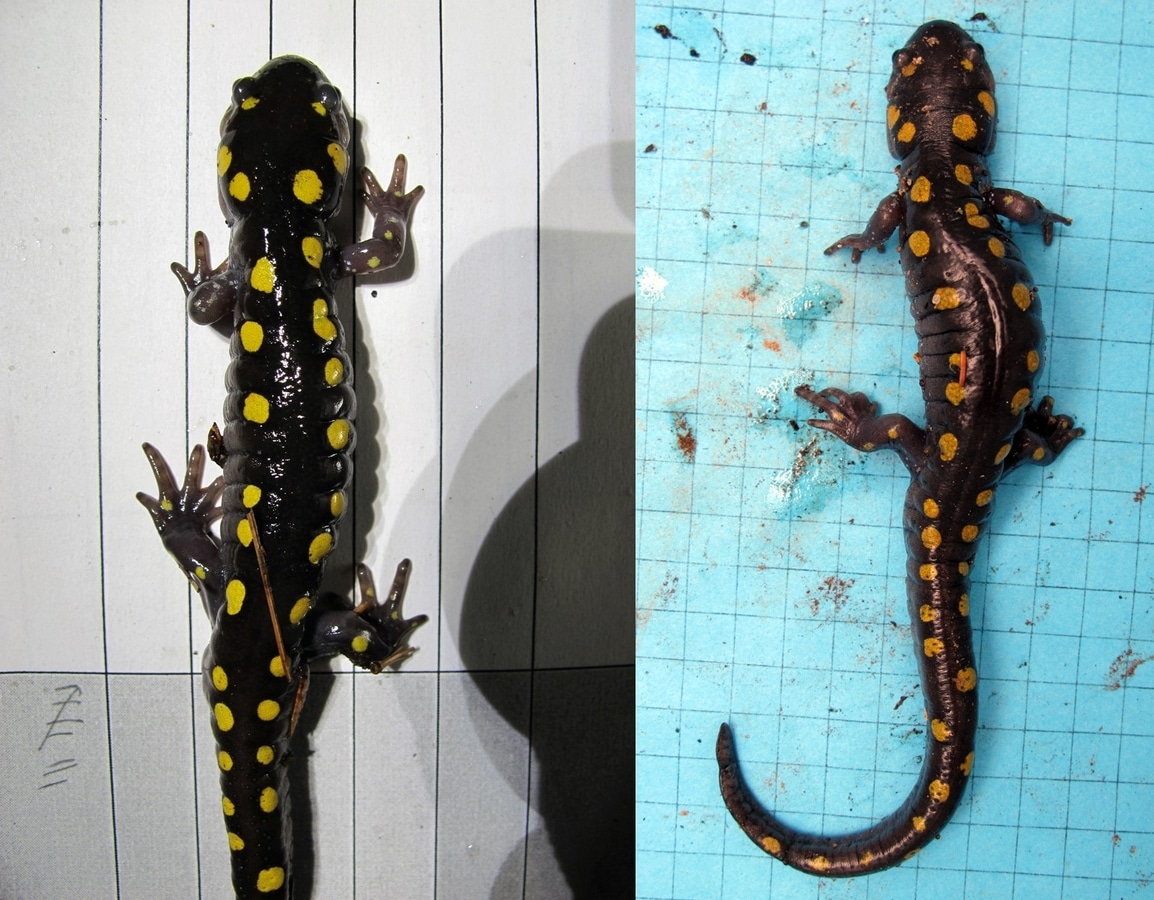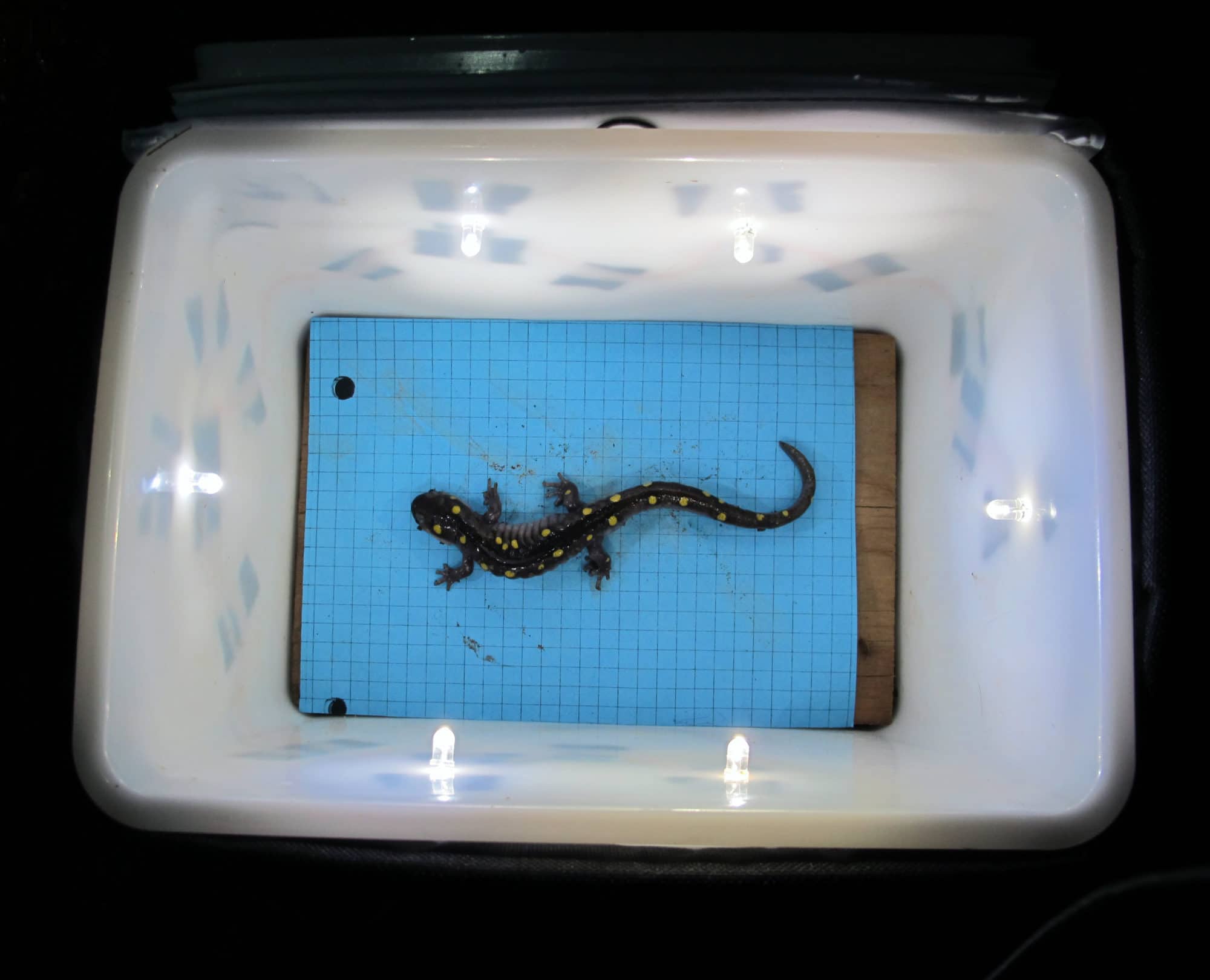
The spots on adult spotted salamanders are like fingerprints on humans: each salamander has its own unique constellation of markings. (photo © Brett Amy Thelen)
The spots on adult spotted salamanders are like fingerprints on humans: each salamander has its own unique constellation of markings, which can be used to tell that individual apart from all the others. We’ve undertaken a special project to create a photographic database of individual spotted salamanders at well-established amphibian road crossings associated with our Salamander Crossing Brigades. Over time, these spot pattern records could provide meaningful information on year-to-year survival in spotted salamander populations that must cross roads to reach their breeding pools. Read on for tips on how to take photos for inclusion in the database!
Stick With Spotties
Although we love to see and share photos of all kinds of amphibians, only spotted salamanders have one-of-a-kind markings, so only spotted salamander photos will be included in this database.
Time After Time
Spotted salamanders are creatures of habit, returning to the same breeding sites year after year. The value of the spot pattern database lies in comparing pictures from the same sites from one year to the next, and seeing which individual salamanders re-appear.

This spotted salamander was found at the North Lincoln Street road crossing in Keene on both 4/11/14 (left) and 4/27/14 (right). Note the distinctive spot pattern on the animal’s head and upper back, which is unique to this individual. See other photos of individual salamanders that have been encountered multiple times here.
Starting in 2020: Although we’ve accepted photos from many sites in the past, for ease of data management we are now concentrating our efforts on a few long-established sites that have a consistent salamander and volunteer presence year after year. Moving forward, please only submit spot pattern photos from the following crossings:
- North Lincoln Street (Keene)
- Jordan Road (Keene)
- Matthews Road (Swanzey)
- Swanzey Lake Road (Swanzey)
- Nelson Road (Nelson)
Head Shots
The best way to identify a spot pattern is by looking at the top of a salamander’s head and upper body, so take your picture from above, and make sure the head, back, and both sides of the salamander are visible and in focus. You’ll get a better shot if you have a friend shine a light on the salamander while you take the picture, though you may need to experiment with the angle of the light to minimize glare. Sometimes, using a clipboard or data form as a backdrop can help.
One and Done
To minimize confusion, please send just one photo per salamander.
Don’t Forget the Data!

Some crossing sites may have a “lightbox” — a small cooler modified with battery-powered LED lights — for easier salamander photography. (photo © Brett Amy Thelen)
These photos are only as useful as the information that comes along with them. Be sure to include:
- the date the photo was taken, including the year;
- the name of the crossing site; and
- a unique number for each individual salamander, to distinguish it from the other photos taken on the same night at the same crossing.
Without this information, your photo is just a photo. With this information, your photo is data! Ideally, you’ll re-name the photo file to include all three pieces of information. Ex: NorthLincolnSt_041515-1.jpg; NorthLincolnSt_041515-2.jpg; and so forth. Submit photos and accompanying information via the link on our Volunteer Materials page.
File Size Specs
If possible, please re-size your photos so they’re bigger than a thumbnail, smaller than a poster. On a smartphone, this will be either the “large” or “original” size. “Small” or “medium” size files, especially when taken under low-light conditions, may not reveal enough detail for spot pattern recognition.
Contact Us
For more information on this or any other aspect of our Salamander Crossing Brigades, please contact Brett Amy Thelen at (603) 358-2065 or by email.

